AASB 102 Impact on Financials: A Case Study of Coca Cola Amatil
VerifiedAdded on 2023/06/11
|6
|1352
|364
Report
AI Summary
This report provides an analysis of business accounting practices, focusing on the implementation of AASB standards, particularly AASB 101 and AASB 102, using Coca Cola Amatil Limited as a case study. It evaluates the measurement of inventory according to accounting standards, identifies the inventory system used by the company, and examines the costing method adopted, discussing the rationale behind it. Furthermore, the report estimates the impact of different costing methods on the company's financial statements, considering factors like FIFO, LIFO and activity-based costing. The study highlights the importance of aligning accounting practices with regulatory standards and the impact of inventory management on financial reporting.
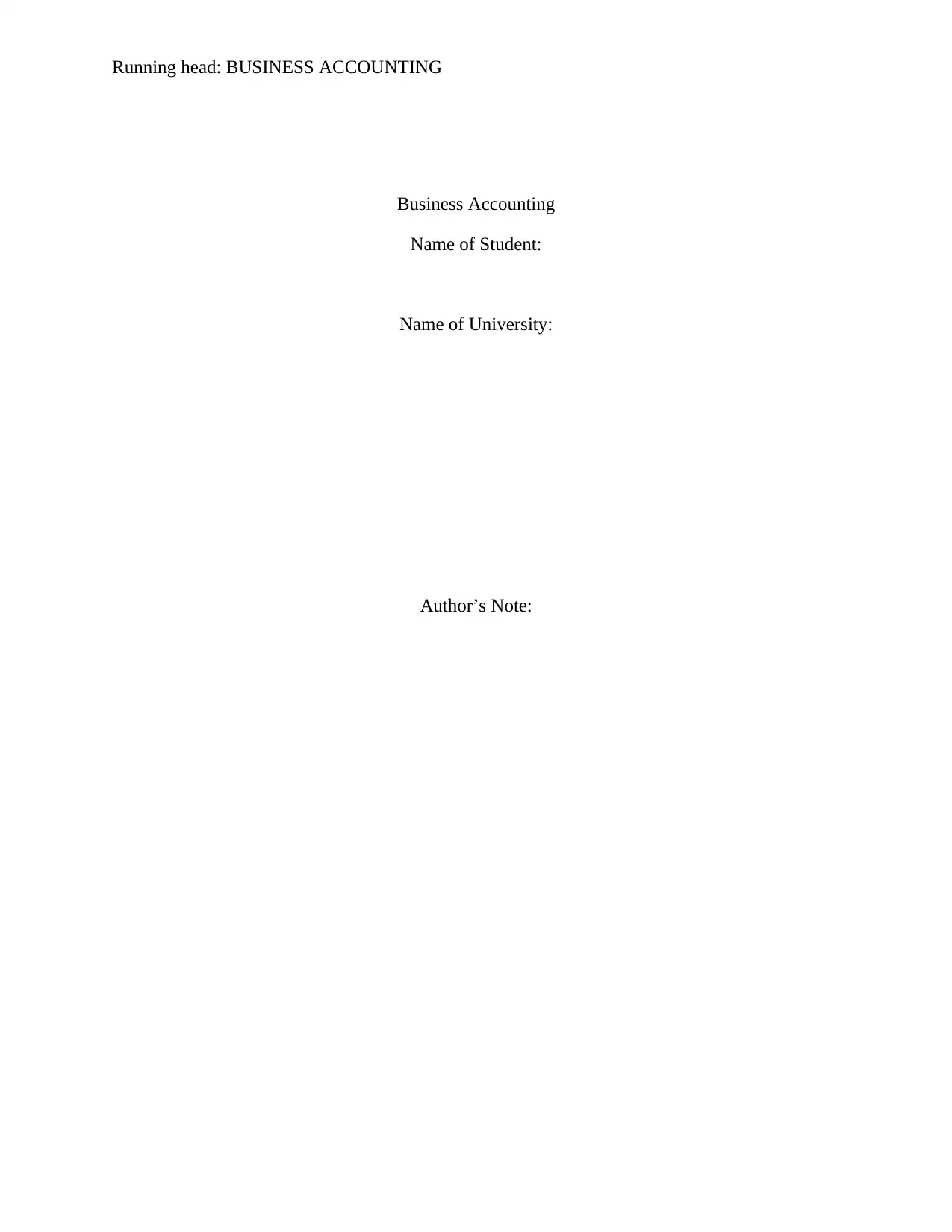
Running head: BUSINESS ACCOUNTING
Business Accounting
Name of Student:
Name of University:
Author’s Note:
Business Accounting
Name of Student:
Name of University:
Author’s Note:
Paraphrase This Document
Need a fresh take? Get an instant paraphrase of this document with our AI Paraphraser
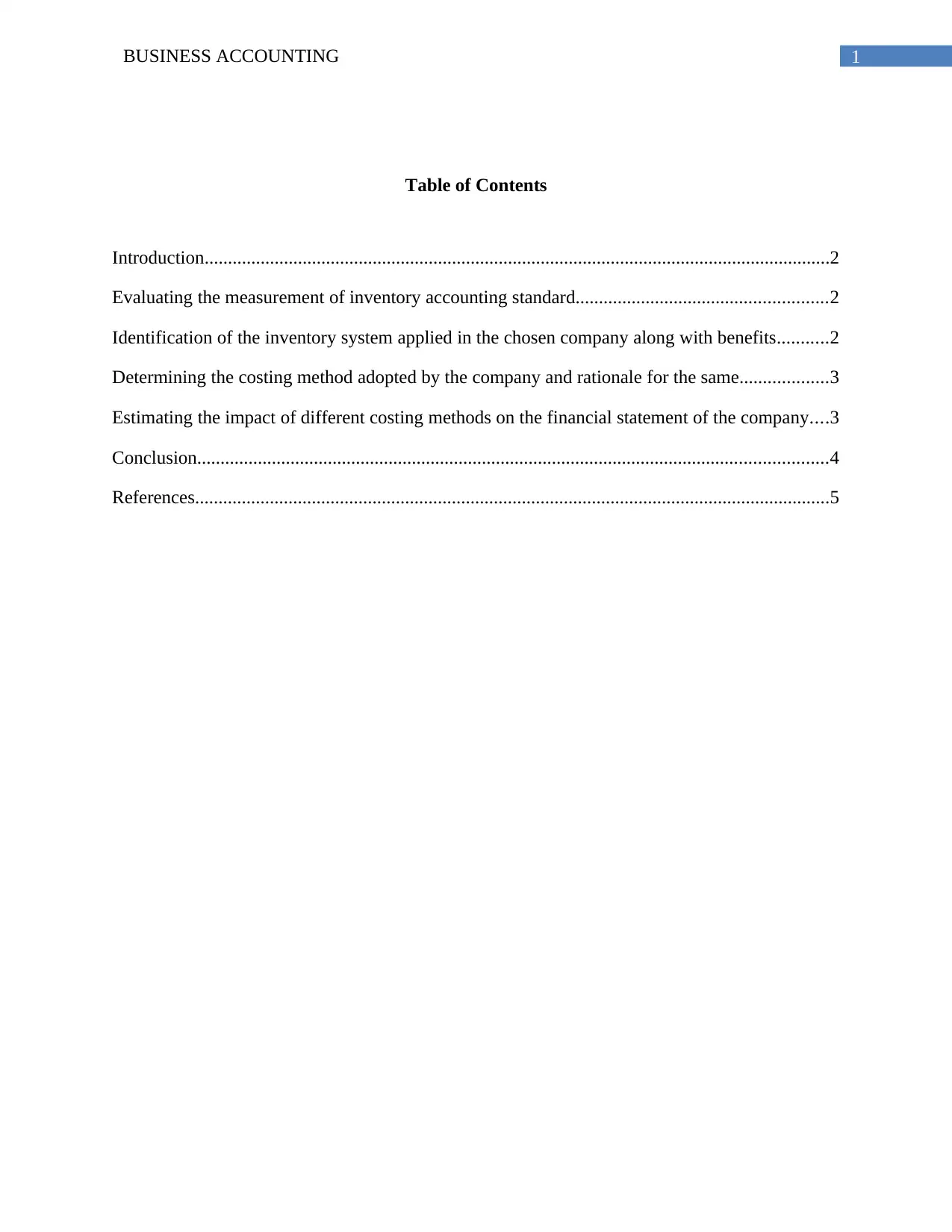
1BUSINESS ACCOUNTING
Table of Contents
Introduction......................................................................................................................................2
Evaluating the measurement of inventory accounting standard......................................................2
Identification of the inventory system applied in the chosen company along with benefits...........2
Determining the costing method adopted by the company and rationale for the same...................3
Estimating the impact of different costing methods on the financial statement of the company....3
Conclusion.......................................................................................................................................4
References........................................................................................................................................5
Table of Contents
Introduction......................................................................................................................................2
Evaluating the measurement of inventory accounting standard......................................................2
Identification of the inventory system applied in the chosen company along with benefits...........2
Determining the costing method adopted by the company and rationale for the same...................3
Estimating the impact of different costing methods on the financial statement of the company....3
Conclusion.......................................................................................................................................4
References........................................................................................................................................5
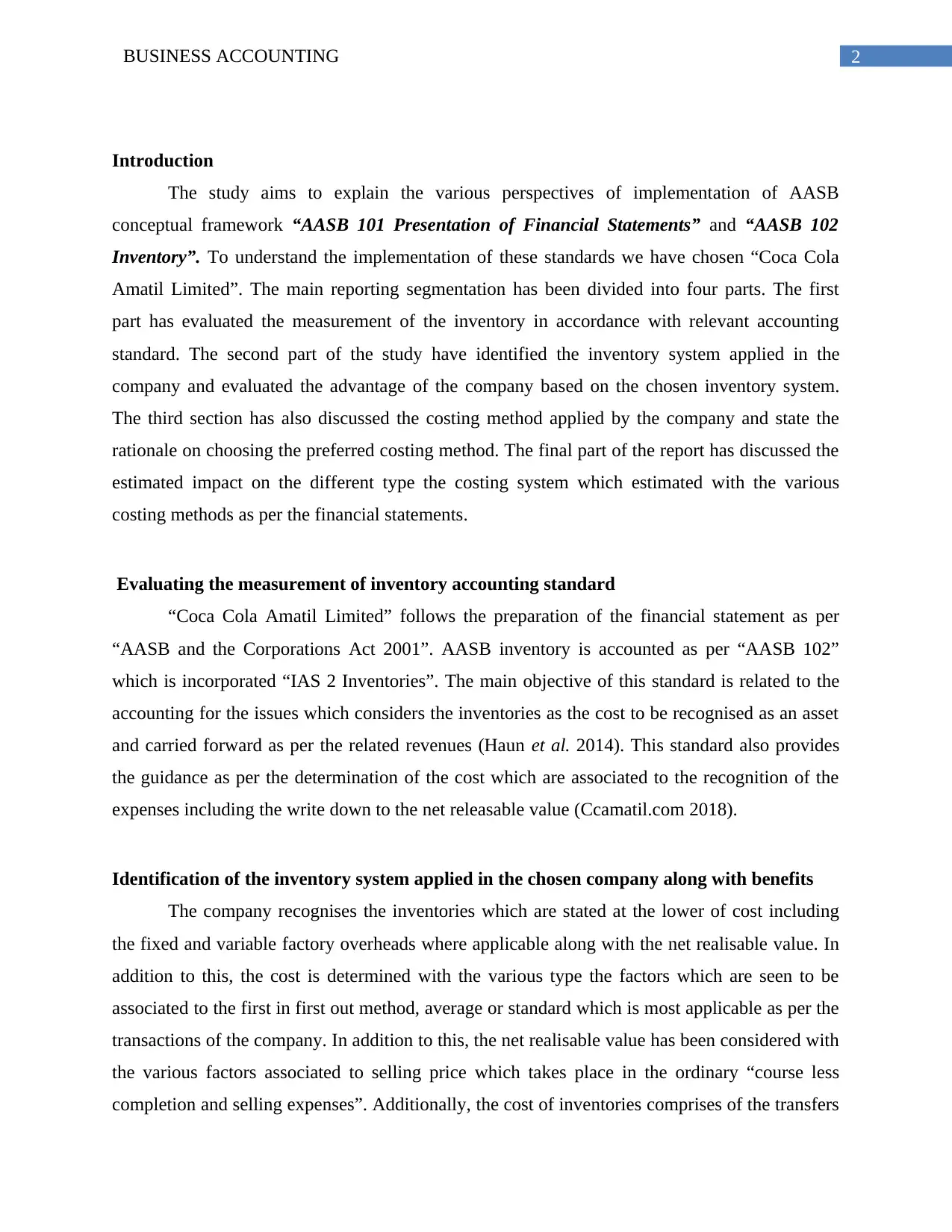
2BUSINESS ACCOUNTING
Introduction
The study aims to explain the various perspectives of implementation of AASB
conceptual framework “AASB 101 Presentation of Financial Statements” and “AASB 102
Inventory”. To understand the implementation of these standards we have chosen “Coca Cola
Amatil Limited”. The main reporting segmentation has been divided into four parts. The first
part has evaluated the measurement of the inventory in accordance with relevant accounting
standard. The second part of the study have identified the inventory system applied in the
company and evaluated the advantage of the company based on the chosen inventory system.
The third section has also discussed the costing method applied by the company and state the
rationale on choosing the preferred costing method. The final part of the report has discussed the
estimated impact on the different type the costing system which estimated with the various
costing methods as per the financial statements.
Evaluating the measurement of inventory accounting standard
“Coca Cola Amatil Limited” follows the preparation of the financial statement as per
“AASB and the Corporations Act 2001”. AASB inventory is accounted as per “AASB 102”
which is incorporated “IAS 2 Inventories”. The main objective of this standard is related to the
accounting for the issues which considers the inventories as the cost to be recognised as an asset
and carried forward as per the related revenues (Haun et al. 2014). This standard also provides
the guidance as per the determination of the cost which are associated to the recognition of the
expenses including the write down to the net releasable value (Ccamatil.com 2018).
Identification of the inventory system applied in the chosen company along with benefits
The company recognises the inventories which are stated at the lower of cost including
the fixed and variable factory overheads where applicable along with the net realisable value. In
addition to this, the cost is determined with the various type the factors which are seen to be
associated to the first in first out method, average or standard which is most applicable as per the
transactions of the company. In addition to this, the net realisable value has been considered with
the various factors associated to selling price which takes place in the ordinary “course less
completion and selling expenses”. Additionally, the cost of inventories comprises of the transfers
Introduction
The study aims to explain the various perspectives of implementation of AASB
conceptual framework “AASB 101 Presentation of Financial Statements” and “AASB 102
Inventory”. To understand the implementation of these standards we have chosen “Coca Cola
Amatil Limited”. The main reporting segmentation has been divided into four parts. The first
part has evaluated the measurement of the inventory in accordance with relevant accounting
standard. The second part of the study have identified the inventory system applied in the
company and evaluated the advantage of the company based on the chosen inventory system.
The third section has also discussed the costing method applied by the company and state the
rationale on choosing the preferred costing method. The final part of the report has discussed the
estimated impact on the different type the costing system which estimated with the various
costing methods as per the financial statements.
Evaluating the measurement of inventory accounting standard
“Coca Cola Amatil Limited” follows the preparation of the financial statement as per
“AASB and the Corporations Act 2001”. AASB inventory is accounted as per “AASB 102”
which is incorporated “IAS 2 Inventories”. The main objective of this standard is related to the
accounting for the issues which considers the inventories as the cost to be recognised as an asset
and carried forward as per the related revenues (Haun et al. 2014). This standard also provides
the guidance as per the determination of the cost which are associated to the recognition of the
expenses including the write down to the net releasable value (Ccamatil.com 2018).
Identification of the inventory system applied in the chosen company along with benefits
The company recognises the inventories which are stated at the lower of cost including
the fixed and variable factory overheads where applicable along with the net realisable value. In
addition to this, the cost is determined with the various type the factors which are seen to be
associated to the first in first out method, average or standard which is most applicable as per the
transactions of the company. In addition to this, the net realisable value has been considered with
the various factors associated to selling price which takes place in the ordinary “course less
completion and selling expenses”. Additionally, the cost of inventories comprises of the transfers
⊘ This is a preview!⊘
Do you want full access?
Subscribe today to unlock all pages.

Trusted by 1+ million students worldwide
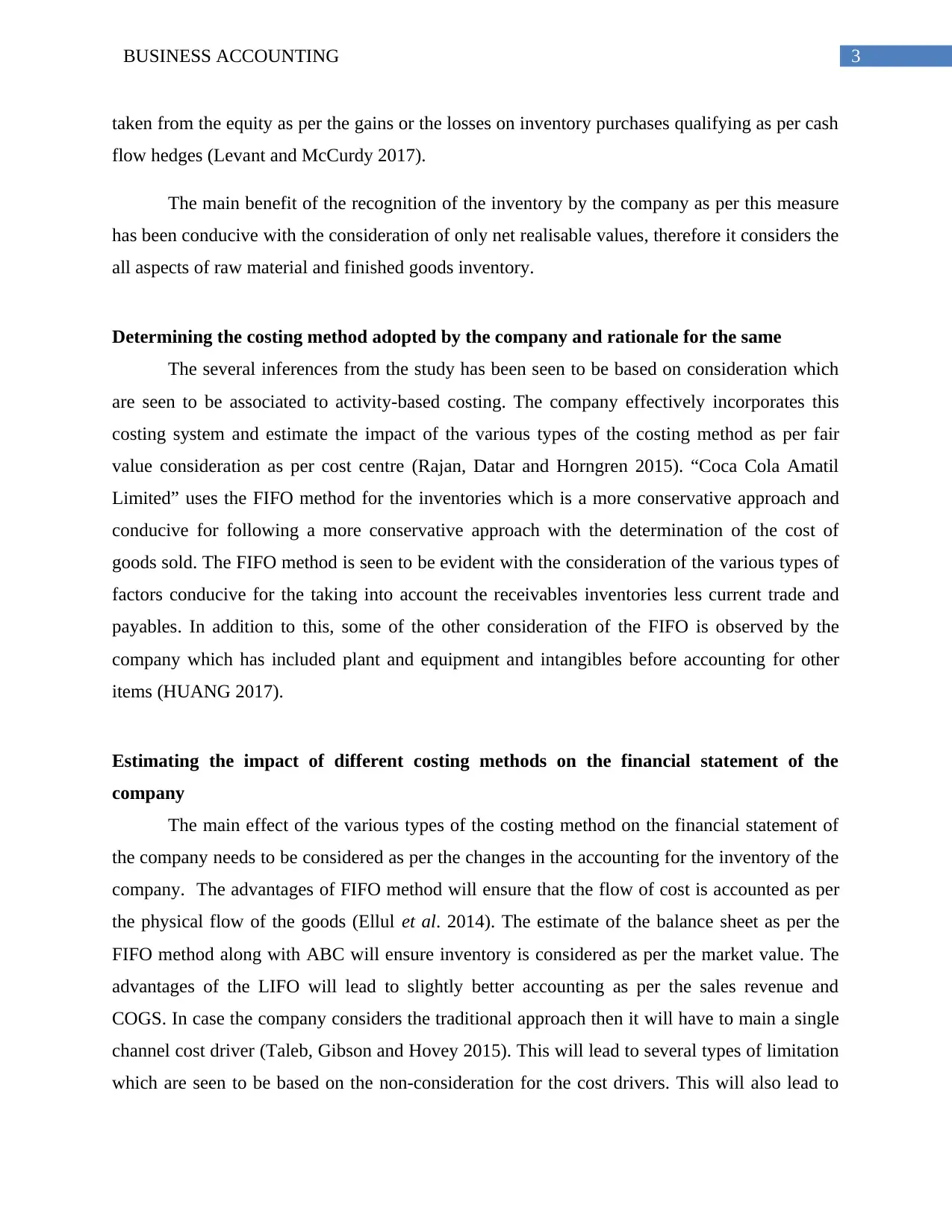
3BUSINESS ACCOUNTING
taken from the equity as per the gains or the losses on inventory purchases qualifying as per cash
flow hedges (Levant and McCurdy 2017).
The main benefit of the recognition of the inventory by the company as per this measure
has been conducive with the consideration of only net realisable values, therefore it considers the
all aspects of raw material and finished goods inventory.
Determining the costing method adopted by the company and rationale for the same
The several inferences from the study has been seen to be based on consideration which
are seen to be associated to activity-based costing. The company effectively incorporates this
costing system and estimate the impact of the various types of the costing method as per fair
value consideration as per cost centre (Rajan, Datar and Horngren 2015). “Coca Cola Amatil
Limited” uses the FIFO method for the inventories which is a more conservative approach and
conducive for following a more conservative approach with the determination of the cost of
goods sold. The FIFO method is seen to be evident with the consideration of the various types of
factors conducive for the taking into account the receivables inventories less current trade and
payables. In addition to this, some of the other consideration of the FIFO is observed by the
company which has included plant and equipment and intangibles before accounting for other
items (HUANG 2017).
Estimating the impact of different costing methods on the financial statement of the
company
The main effect of the various types of the costing method on the financial statement of
the company needs to be considered as per the changes in the accounting for the inventory of the
company. The advantages of FIFO method will ensure that the flow of cost is accounted as per
the physical flow of the goods (Ellul et al. 2014). The estimate of the balance sheet as per the
FIFO method along with ABC will ensure inventory is considered as per the market value. The
advantages of the LIFO will lead to slightly better accounting as per the sales revenue and
COGS. In case the company considers the traditional approach then it will have to main a single
channel cost driver (Taleb, Gibson and Hovey 2015). This will lead to several types of limitation
which are seen to be based on the non-consideration for the cost drivers. This will also lead to
taken from the equity as per the gains or the losses on inventory purchases qualifying as per cash
flow hedges (Levant and McCurdy 2017).
The main benefit of the recognition of the inventory by the company as per this measure
has been conducive with the consideration of only net realisable values, therefore it considers the
all aspects of raw material and finished goods inventory.
Determining the costing method adopted by the company and rationale for the same
The several inferences from the study has been seen to be based on consideration which
are seen to be associated to activity-based costing. The company effectively incorporates this
costing system and estimate the impact of the various types of the costing method as per fair
value consideration as per cost centre (Rajan, Datar and Horngren 2015). “Coca Cola Amatil
Limited” uses the FIFO method for the inventories which is a more conservative approach and
conducive for following a more conservative approach with the determination of the cost of
goods sold. The FIFO method is seen to be evident with the consideration of the various types of
factors conducive for the taking into account the receivables inventories less current trade and
payables. In addition to this, some of the other consideration of the FIFO is observed by the
company which has included plant and equipment and intangibles before accounting for other
items (HUANG 2017).
Estimating the impact of different costing methods on the financial statement of the
company
The main effect of the various types of the costing method on the financial statement of
the company needs to be considered as per the changes in the accounting for the inventory of the
company. The advantages of FIFO method will ensure that the flow of cost is accounted as per
the physical flow of the goods (Ellul et al. 2014). The estimate of the balance sheet as per the
FIFO method along with ABC will ensure inventory is considered as per the market value. The
advantages of the LIFO will lead to slightly better accounting as per the sales revenue and
COGS. In case the company considers the traditional approach then it will have to main a single
channel cost driver (Taleb, Gibson and Hovey 2015). This will lead to several types of limitation
which are seen to be based on the non-consideration for the cost drivers. This will also lead to
Paraphrase This Document
Need a fresh take? Get an instant paraphrase of this document with our AI Paraphraser
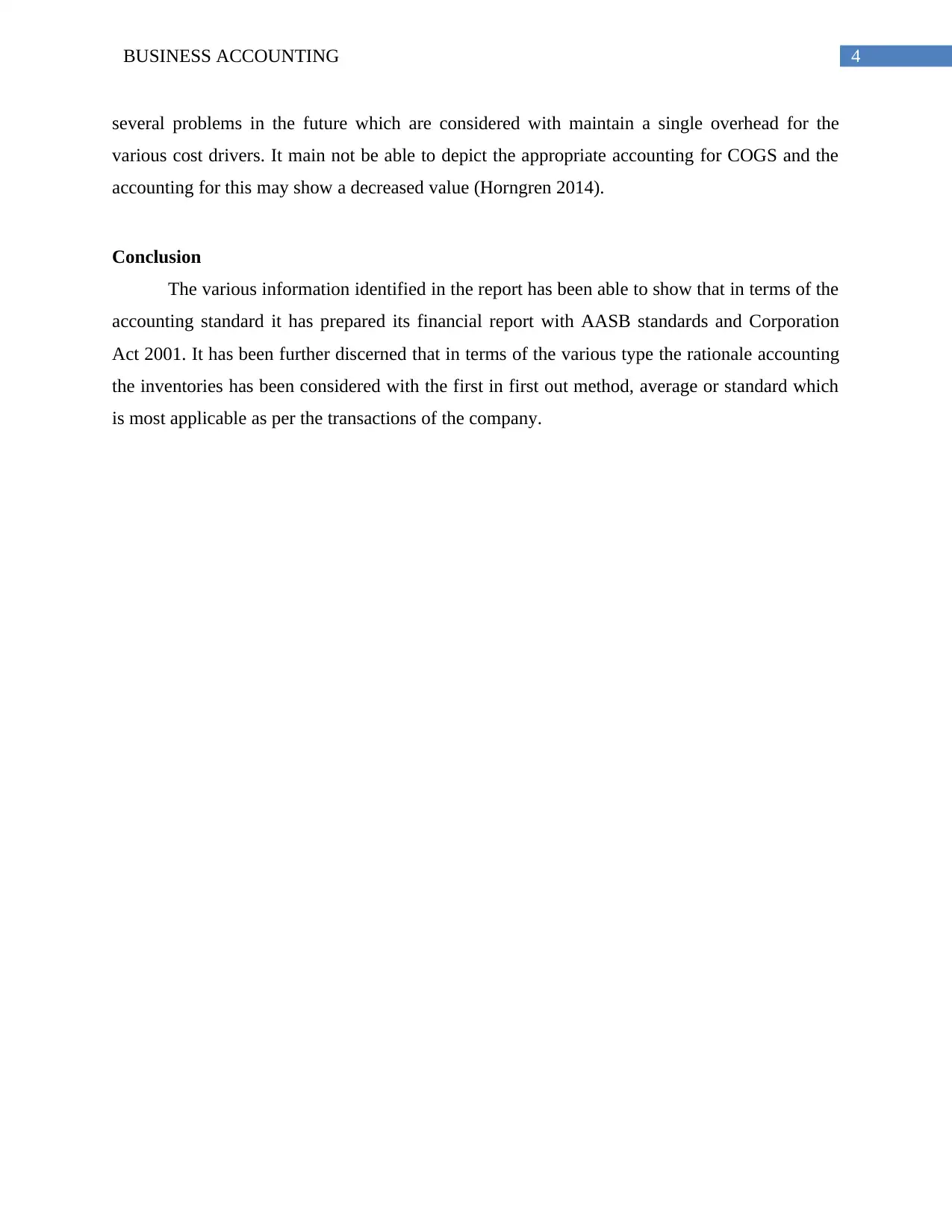
4BUSINESS ACCOUNTING
several problems in the future which are considered with maintain a single overhead for the
various cost drivers. It main not be able to depict the appropriate accounting for COGS and the
accounting for this may show a decreased value (Horngren 2014).
Conclusion
The various information identified in the report has been able to show that in terms of the
accounting standard it has prepared its financial report with AASB standards and Corporation
Act 2001. It has been further discerned that in terms of the various type the rationale accounting
the inventories has been considered with the first in first out method, average or standard which
is most applicable as per the transactions of the company.
several problems in the future which are considered with maintain a single overhead for the
various cost drivers. It main not be able to depict the appropriate accounting for COGS and the
accounting for this may show a decreased value (Horngren 2014).
Conclusion
The various information identified in the report has been able to show that in terms of the
accounting standard it has prepared its financial report with AASB standards and Corporation
Act 2001. It has been further discerned that in terms of the various type the rationale accounting
the inventories has been considered with the first in first out method, average or standard which
is most applicable as per the transactions of the company.
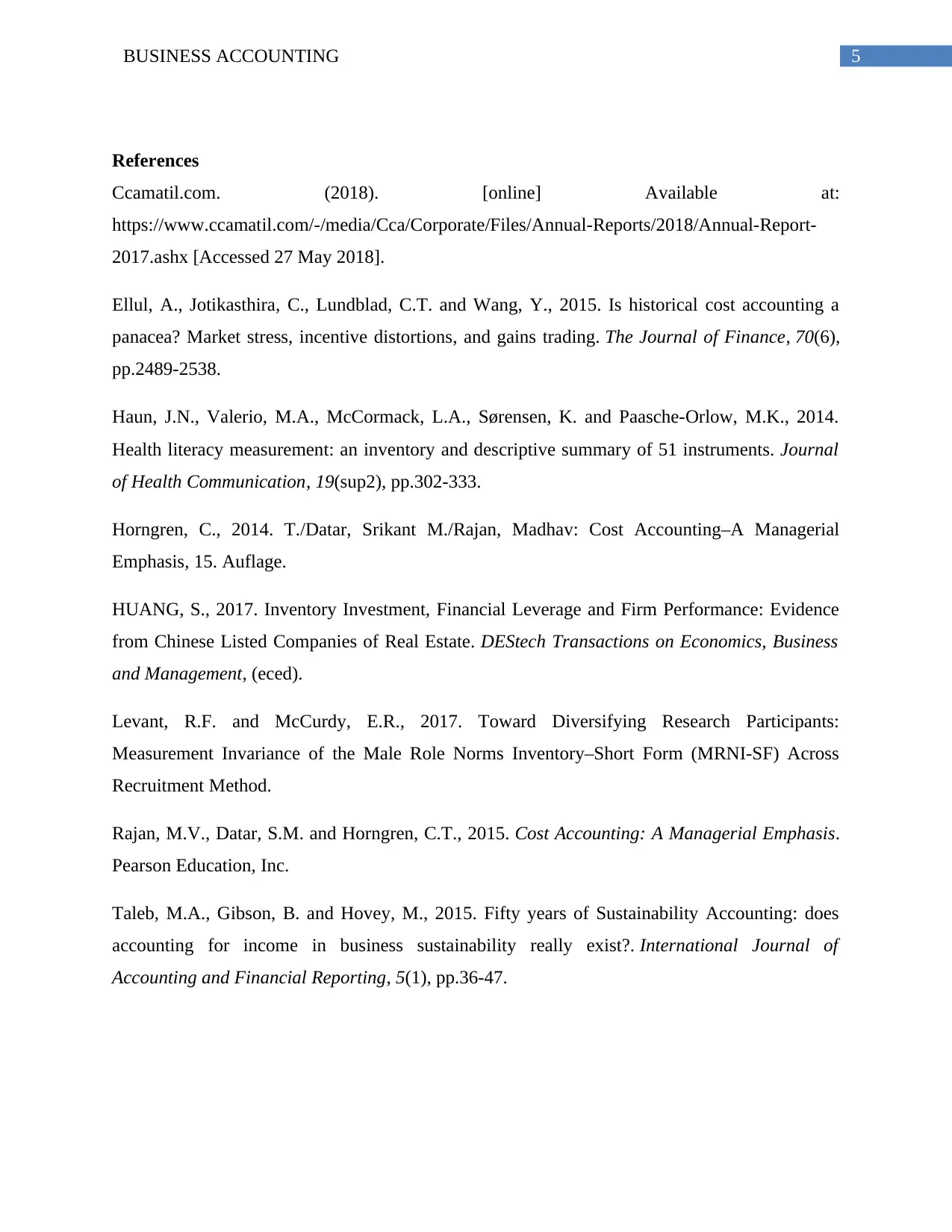
5BUSINESS ACCOUNTING
References
Ccamatil.com. (2018). [online] Available at:
https://www.ccamatil.com/-/media/Cca/Corporate/Files/Annual-Reports/2018/Annual-Report-
2017.ashx [Accessed 27 May 2018].
Ellul, A., Jotikasthira, C., Lundblad, C.T. and Wang, Y., 2015. Is historical cost accounting a
panacea? Market stress, incentive distortions, and gains trading. The Journal of Finance, 70(6),
pp.2489-2538.
Haun, J.N., Valerio, M.A., McCormack, L.A., Sørensen, K. and Paasche-Orlow, M.K., 2014.
Health literacy measurement: an inventory and descriptive summary of 51 instruments. Journal
of Health Communication, 19(sup2), pp.302-333.
Horngren, C., 2014. T./Datar, Srikant M./Rajan, Madhav: Cost Accounting–A Managerial
Emphasis, 15. Auflage.
HUANG, S., 2017. Inventory Investment, Financial Leverage and Firm Performance: Evidence
from Chinese Listed Companies of Real Estate. DEStech Transactions on Economics, Business
and Management, (eced).
Levant, R.F. and McCurdy, E.R., 2017. Toward Diversifying Research Participants:
Measurement Invariance of the Male Role Norms Inventory–Short Form (MRNI-SF) Across
Recruitment Method.
Rajan, M.V., Datar, S.M. and Horngren, C.T., 2015. Cost Accounting: A Managerial Emphasis.
Pearson Education, Inc.
Taleb, M.A., Gibson, B. and Hovey, M., 2015. Fifty years of Sustainability Accounting: does
accounting for income in business sustainability really exist?. International Journal of
Accounting and Financial Reporting, 5(1), pp.36-47.
References
Ccamatil.com. (2018). [online] Available at:
https://www.ccamatil.com/-/media/Cca/Corporate/Files/Annual-Reports/2018/Annual-Report-
2017.ashx [Accessed 27 May 2018].
Ellul, A., Jotikasthira, C., Lundblad, C.T. and Wang, Y., 2015. Is historical cost accounting a
panacea? Market stress, incentive distortions, and gains trading. The Journal of Finance, 70(6),
pp.2489-2538.
Haun, J.N., Valerio, M.A., McCormack, L.A., Sørensen, K. and Paasche-Orlow, M.K., 2014.
Health literacy measurement: an inventory and descriptive summary of 51 instruments. Journal
of Health Communication, 19(sup2), pp.302-333.
Horngren, C., 2014. T./Datar, Srikant M./Rajan, Madhav: Cost Accounting–A Managerial
Emphasis, 15. Auflage.
HUANG, S., 2017. Inventory Investment, Financial Leverage and Firm Performance: Evidence
from Chinese Listed Companies of Real Estate. DEStech Transactions on Economics, Business
and Management, (eced).
Levant, R.F. and McCurdy, E.R., 2017. Toward Diversifying Research Participants:
Measurement Invariance of the Male Role Norms Inventory–Short Form (MRNI-SF) Across
Recruitment Method.
Rajan, M.V., Datar, S.M. and Horngren, C.T., 2015. Cost Accounting: A Managerial Emphasis.
Pearson Education, Inc.
Taleb, M.A., Gibson, B. and Hovey, M., 2015. Fifty years of Sustainability Accounting: does
accounting for income in business sustainability really exist?. International Journal of
Accounting and Financial Reporting, 5(1), pp.36-47.
⊘ This is a preview!⊘
Do you want full access?
Subscribe today to unlock all pages.

Trusted by 1+ million students worldwide
1 out of 6
Related Documents
Your All-in-One AI-Powered Toolkit for Academic Success.
+13062052269
info@desklib.com
Available 24*7 on WhatsApp / Email
![[object Object]](/_next/static/media/star-bottom.7253800d.svg)
Unlock your academic potential
Copyright © 2020–2025 A2Z Services. All Rights Reserved. Developed and managed by ZUCOL.





